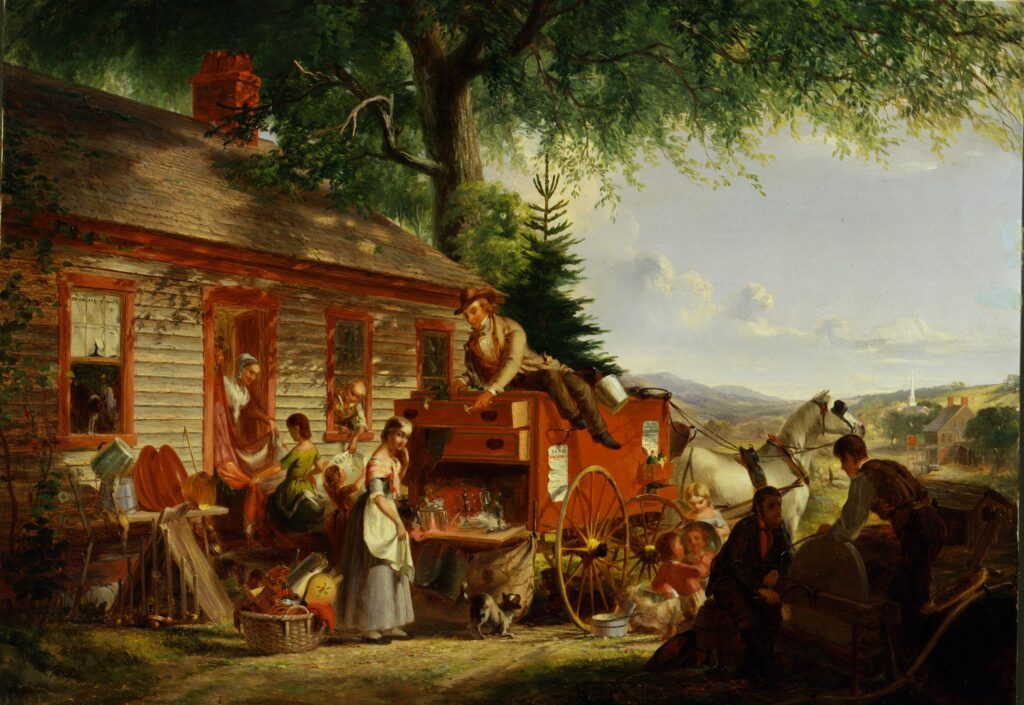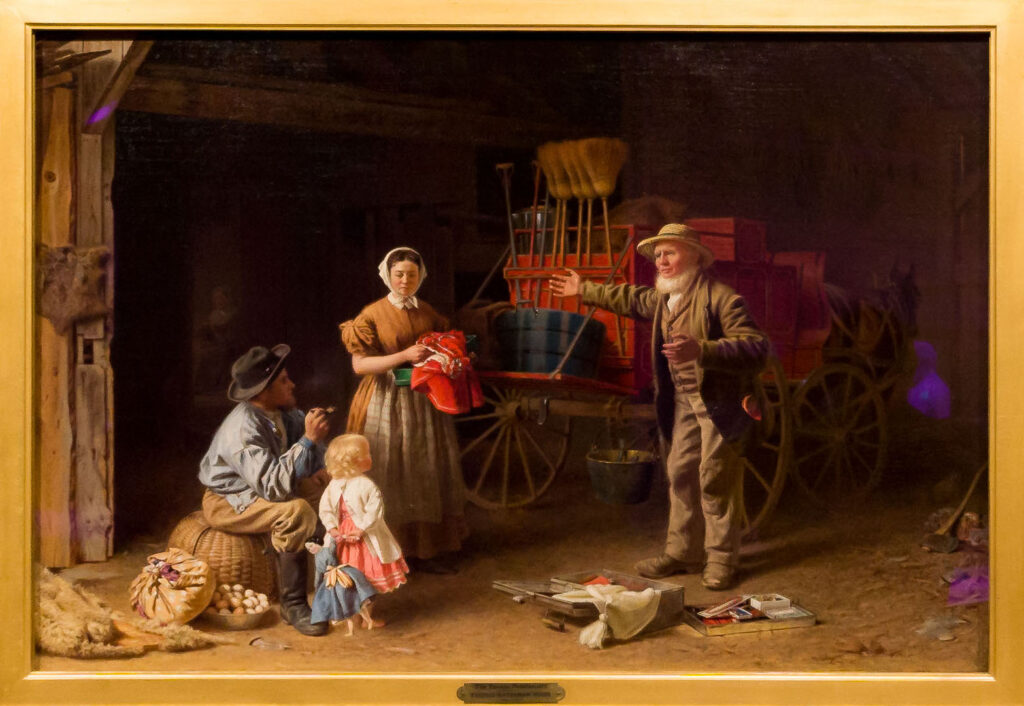- Game Play:
- Distribute cards to families, face down. All families should have the same number of commodity and cash cards (but not the same cards).
- The Yankee Peddler introduces himself, the number of items he has for sale, and the bidding process. He then introduces the first object. Sell it! As the Yankee Peddler, you want the highest price possible. Go ahead and give details about production, distribution, and social value of commodities. Do NOT reveal prices. Anxiety over how much the item is “worth” is a feature, not a bug, of the game.
- Families submit bids, face down.
- After collecting all bids, the family who has submitted the highest bid buys the item. The peddler can refuse to sell an item. Students often bid very low at the beginning and then very high toward the end of the game.
- To Win: when all commodities have been sold, tally up a final profit and loss for the peddler. Which family got the best deals for their produce relative to the cost? That family wins the game.
Conclusion
In drawing the game to a close, circle back to the discussions of market-based anxieties.
How do you know if you got a good deal? How do you know how much an item was “worth”?
What shapes prices? Is it just supply and demand? Is it the costs to bring an item to market? Discussing the social value of the goods and what went into their own evaluation of their bidding process can be worthwhile. How did competition shape the game? How might it have played out differently with open bidding? Do these capitalist market transactions feel like gambling?
Many other subjects can be incorporated into the game or its surrounding lesson plan. I started this game for my History of US Capitalism course, with a day on the reorganization of labor, industrialization, and child labor and another on banking controversies. I include yarns that reveal the “Yankee peddler” to be a global figure and connect him to foreign trade. Part of the utility of the game is how many intersections can be addressed, a Choose Your Own Adventure of lesson planning. Find any favorites in your own classroom? Please share!
Further Reading
On the history of game production, see Philip Orbanes, The Game Makers: The Story of Parker Brothers, from Tiddledy Winks to Trivial Pursuit (Cambridge: Harvard Business Review Press, 2003). On a provocative essay on those earlier games and morality, see introduction of Jill Lepore, Mansion of Happiness: A History of Life and Death (New York: Knopf, 2012).
While textbooks still frequently refer to the Market Revolution, rooted in books like Charles Sellers, The Market Revolution: Jacksonian America, 1815-1846 (New York: Oxford University Press, 1991), this game is not contingent upon that concept. More recent work, like Jonathan Levy’s Ages of American Capitalism: A History of the United States (New York: Penguin Random House, 2021) and Eli Cook, The Pricing of Progress: Economic Indicators and the Capitalization of American Life (Cambridge: Harvard University Press, 2017) favor a focus on infrastructure per George Taylor, The Transportation Revolution, 1815-1860 (New York: Rinehart and Company, 1951).
On Yankee peddlers, see David Jaffee, A New Nation of Goods: The Material Culture of Early America (Philadelphia: University of Pennsylvania Press, 2010) and “Peddlers of Progress and the Transformation of the Rural North, 1760-1860,” Journal of American History 78 (Sept. 1991): 511-35; Joseph T. Rainer, “The ‘Sharper’ Image: Yankee Peddlers, Southern Consumers, and the Market Revolution,” Business and Economic History 26 (Fall 1997): 27-44; T. Jackson Lears, Fables of Abundance: A Cultural History of Advertising in America (New York: Basic Books, 1994); J. R. Dolan, The Yankee Peddlers of Early America: An Affectionate History of Life and Commerce in the Developing Colonies and the Early Republic (New York: Clarkson N. Potter, Inc., 1964). For more on folklore, see Constance Rourke, American Humor: A Study of the National Character (New York: Harcourt, Brace and Company, 1931) and Chaim M. Rosenberg, Yankee Colonies Across America: Cities upon the Hills (New York: Lexington Books, 2015). For art history, see Terrence H. Witkowski, “Farmers Bargaining: Buying and Selling as a Subject in American Genre Painting, 1835-1868,” Journal of Macromarketing 16 (no. 2, 1996): 84-101.
A few classic works on capitalism as a game, see Ann Fabian, Card Sharps and Bucket Shops: Gambling in Nineteenth-Century America (New York: Routledge, 1999); Jane Kamensky, The Exchange Artist: A Tale of High-Flying Speculation and America’s First Banking Collapse (New York: Viking, 2008); Karen Haltunnen, Confidence Men and Painted Ladies: A Study of Middle-Class Culture in America, 1830-1870 (New Haven, Conn.: Yale University Press, 1982); Scott A. Sandage, Born Losers: A History of Failure in America (Cambridge: Harvard University Press, 2009).
On the history of money, see Joshua Greenberg, Bank Notes & Shinplasters: The Rage for Paper Money in the Early Republic (Philadelphia: University of Pennsylvania Press, 2020); John McCusker, Money and Exchange in Europe and America, 1680-1775: A Handbook (Chapel Hill: University of North Carolina Press, 1992).
On the global Yankee trader, see, for example, Jonathan Eacott, Selling Empire: India and the Making of Britain and America (Chapel Hill: University of North Carolina Press, 2016); Kariann Yokota, Unbecoming British: How Revolutionary America Became a Postcolonial Nation (New York: Oxford University Press, 2011); James Fichter, So Great a Profitt: How the East Indies Trade Transformed Anglo-American Capitalism (Cambridge: Harvard University Press, 2010); Susan Bean, Yankee India: American Commercial and Cultural Encounters with India in the Age of Sail, 1784-1860 (Salem, Mass.: Peabody Essex Museum, 2001).
This article originally appeared in July 2023.
Rachel Tamar Van teaches early American history, the history of US capitalism, and family and genealogical history at Cal Poly Pomona in southern California. She has articles you might use to expand on the US China trade in Diplomatic History, the Pacific Historical Review, and the Routledge History of US Foreign Relations.














